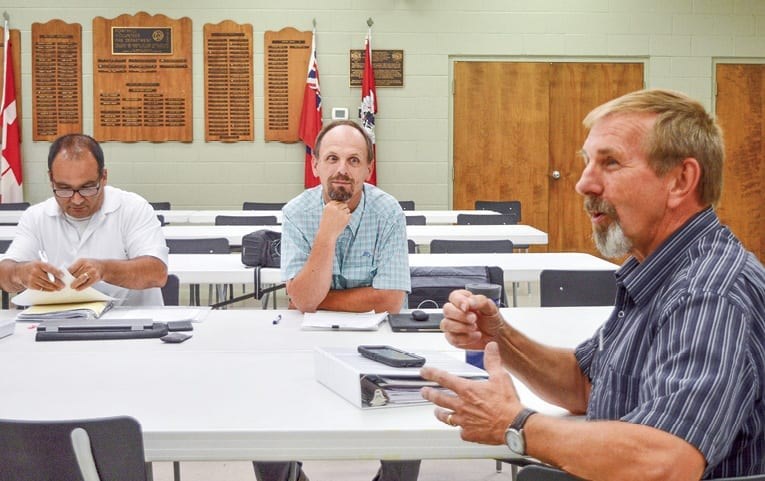BY GLORIA J. KATCH Special to the VOICE
Little did David Cribbs know that his “initiation” as the Town’s new CAO might include leading a public meeting on cannabis legislation that could result in being pelted with rotten tomatoes, teased a few members of the Cannabis Control Committee at their meeting last Wednesday.
Although Cribbs opted for “peaches” in this scenario, the committee discussed plans to obtain the public’s feedback during an information meeting scheduled for September 10 at 6 PM at the community centre. The time may be subject to change, but there will be a public notice officially released 20 days prior to the meeting, and in the Voice.
 The angry mob wielding tomatoes quip was made after committee member Jim Steele said the public meeting would largely attract residents opposed to marijuana facilities in town.
The angry mob wielding tomatoes quip was made after committee member Jim Steele said the public meeting would largely attract residents opposed to marijuana facilities in town.
Committee Chair Tim Nohara said he wanted to deliver a presentation during the public meeting that would not be tied-in with Town’s staff recommendations. Barb Wiens, Director of Planning and Development agreed, but stated the Town would need to present some concrete numbers and “something on paper,” for any professionals attending the meeting, but it would be clarified that any bylaw recommendations were from Town staff and not the committee. (Following the committee meeting, Senior Planner Shannon Larocque said any bylaw amendments proposed are also drafts that the Town is seeking “constructive criticism on.”)
The public meeting would be considering amendments to Zoning Bylaw 1136, with respect to cannabis production in the Town of Pelham, which would attempt to exclude future cannabis facilities in an agricultural area. However, while the bylaw’s intentions were strong, its clauses regulating the distance between cannabis grow-ops and residences were not far enough to satisfy committee members. In the draft proposal presented last week based on other communities and areas, the distance allowance between grow-operations and residences or other farming concerns is 150 metres.
 Member John Langendoen said he met recently with planners in other municipalities, and they stated 300 metres from the property line as being appropriate, especially considering large operations like CannTrust. Member Jim Jeffs said the allowance should be based on knowledge and research in the community, which should be the “number one” consideration. Wiens noted that there are houses within 150 metres of CannTrust.
Member John Langendoen said he met recently with planners in other municipalities, and they stated 300 metres from the property line as being appropriate, especially considering large operations like CannTrust. Member Jim Jeffs said the allowance should be based on knowledge and research in the community, which should be the “number one” consideration. Wiens noted that there are houses within 150 metres of CannTrust.
“If this [setback] number will result in the same situation that we have, then it won’t help this committee mitigate concerns,” pointed out Nohara.
Vice Chair Carla Baxter stated, “We don’t know how they got that number and where they got it from.”
Cribbs told the committee a distance allowance should be determined to “tell us what road to go down,” and “start the discussion.”
Comparing the public meeting to a mid-term report card, Cribbs said it was not meant to indicate that these recommendations were final or that their job was complete.
“I think that most people will say, ‘Why didn’t you do the most – not the least,’” said Steele, pushing for a farther setback.
Larocque later told the Voice that the 150-metre setback was adequate to prevent the problems the town has experienced if all the systems were in place and working properly. Unfortunately, Pelham residents have had a bad experience with cannabis facilities, that she noted has understandably left, “a bad taste in their mouths.”
Nohara reported the committee was not prepared to decide on a number as yet, and if anything, he would rather err on the side of caution, and choose a larger distance allocation to initially present to the public. Larocque then reminded the committee, “this bylaw is not to work alone and you can also look at the site plan agreement,” for more specific control mechanisms.
Baxter asked what the term “obnoxious uses” was and noted it wasn’t included in the draft proposal to the proposed bylaw amendment with regard to cannabis. Larocque used the example of spraying fields as obnoxious, but that was a smell that was considered a part of the common practise of farming. Wiens cited another example of bird bangers that scared off birds, and stated the noise would be considered obnoxious to other people.
“I don’t know that you can say that cannabis is not obnoxious and there isn’t somewhere we can’t deal with it,” noted Nohara.
In reference to Wien’s comment, Damm asserted that it depends on how often the bird bangers go off. There are standards that have to be developed around practises, pointed out Nohara. Damm suggested a definition might be needed for cannabis production for its different types and stages of production, i.e., the flowering or harvesting stage, in order to mitigate odour problems.
The bylaw amendment also included sufficient parking spaces for and cannabis facility’s employees on its largest shift, and an abutment area of a 1.5 metre planting strip from other land uses. The latter being a green strip or buffer area added between properties, also considering that most houses and facilities are not on their property line, noted Larocque.
Damm presented a report on growing cannabis that included detailed information on soils, fertilizers, water and air emissions. Reverse osmosis will be required if well water contains water, manganese, aluminum, arsenic and sodium over World Health Organization (WHO) limits. Damm said Health Canada bases their requirements on WHO standards. Other methods of water treatment include ultraviolet, ozone and other filtration systems.
The question the committee was concerned with: How are these heavy metals being disposed? Damm said he believed heavy metals were being “trucked away” from CannTrust’s and RedeCan Pharm’s septic systems. However, Wiens said the Ministry of Environment monitors their septic systems, and the Town had no authority to ask questions regarding this area of their respective operations.
Baxter said the Town should be able to act if the effluent waste were adversely affecting surrounding properties and the environment. Wiens said the Ministry of Environment standards were so stringent, their well water would be cleaner than ground water. While Damm’s report noted that good business practise in the farm industry included maintaining records, some of the members of the committee appeared sceptical of the recordkeeping and statistics offered by some of the current cannabis grow-operatives. At one point in the meeting, Damm said of CannTrust,“Who the hell knows what goes on in there.”
In his past experience in the hog industry, Damm said any air filtration-type systems are designed for the size of the facility. In his case, each hog had to have so many square feet of space, while these requirements do not appear to exist in the marijuana regulations. The efficiency of the carbon filters should be considered as a part of a peer review. At best, he believed the carbon filters should be a “back-up system,” and not the main component to remove odours from the air. He also pointed out that due to the cleanliness standards of CannTrust, many chemical cleansers like hydrogen peroxide and isopropyl alcohol are used after a cannabis growing room is scrubbed that could easily “burn your eyes.”
Damm later told the Voice that because of the smell of the odour pollution and masking agents used to control the odour emitted from large facilities like CannTrust, other farming crops are negatively impacted.
“How does someone's strawberries taste, because of that odour? How does the hay taste, and what if the horse won’t eat it, because it smells funny?” said Damm. While not opposed to marijuana facilities, he said they need to learn to co-exist with other farming businesses.
“I don’t like the way they just seemed to bulldoze their way into communities.”
Larocque asserted that the bylaws proposed by Town staff will put restrictions on future marijuana grow-operatives, but the difficulty is that even with criteria in place, because of the size of agricultural properties, an expansion of even 10% can create problems.
While everything is still up for discussion, staff is attempting to determine “what’s reasonable,” and, “it’s a challenge we’re trying to wrap our heads around,” Larocque said.



